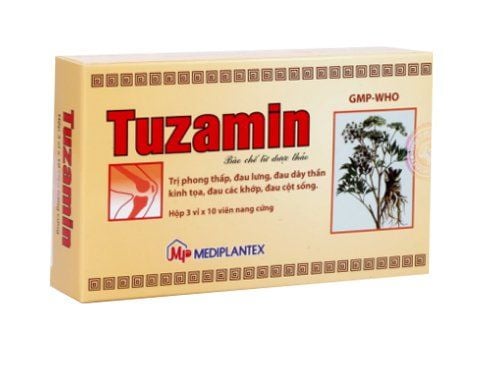This is an automatically translated article.
Rumafar medicine with herbal ingredients is used to treat colds, colds, runny nose and headache... To ensure effective use when using Rumafar, users need to follow the doctor's instructions. doctor, and refer to more information about the use of Rumafar in the following article.
1. What are the effects of Rumafar?
1.1. What is Rumafar? Rumafar drug with registration number VD-17233-12 is a product of Saigon Pharmaceutical Company Limited (Sagophar) manufactured and registered by Branch of Saigon Pharmaceutical Company Limited in Binh Duong - VIETNAM.
Rumafar has the following main ingredients:
Cao Hai Sai (Luc) (Radix Plucheae pteropodae) 0.15g; Rhizoma Ligustici wallichii (Rhizoma Ligustici wallichii) 0.05g; Frutus Viticis trifoliae (Fructus Viticis trifoliae) powder 0.1g; Angelica (Radix Angelicae dahuricae) powder 0.05g; Mainland Powder (Rhizoma Kaempferiae galangae) 0.03g; Alum powder (Alumen) 0.01g; Cinnamon oil; Melaleuca oil; White Basil essential oil; Magnesium stearate; White sugar; Gum Arabic; Talc powder and Ethanol 96%...just enough for 1 tablet. Rumafar is prepared in the form of: Sugar coated tablets, packed in boxes of 03 blisters, 10 tablets each.
1.2. What diseases does Rumafar treat? Rumafar is an OTC medicine, used for the following conditions: cold, cold, headache or runny nose, muscle pain and muscle fatigue. Headaches caused by leprosy enter the brain and pain from welding, arthralgia, contractures and women with blood clots. Symptoms of cold qi or chest pain, hit by evil qi and suddenly painful swelling, flank pain and bleeding gums (special green). Thighs and backs are weak or paralyzed, the placenta does not come out, and the abdomen is painful due to cold. Leprosy, headache and dizziness, abdominal pain or pain due to welding, menstrual cramps, difficulty in giving birth and after birth, blood stasis causes pain, acne. Menstrual irregularities and menstrual cramps, when menstrual cramps, pain in the ribs like needles, pain when falling, headache and rheumatism pain. Menstrual disorders, menstrual cramps, painful menstrual periods, difficult birth, abdominal pain after childbirth, pain in the chest and ribs, numbness in hands and feet, painful boils, falling injuries or rheumatism. Contraindications:
Patients must not use Rumafar in case of a history of hypersensitivity to the ingredients and excipients contained in the drug.
2. Usage of Rumafar
2.1. How to take Rumafar Rumafar is taken by mouth.
2.2. Dosage of the drug Rumafar Children:
From 5 to 9 years old: 3 times a day, 1 tablet each time. From 10 to 15 years old: 3 times a day, 1-2 tablets each time. Adults:
Take 3-4 times a day, 2 tablets each time. Remember that there are many factors that go into determining the dosage of a drug. Usually will depend on the condition, the form of the drug and the object of use. Always follow the dose prescribed on the leaflet and as directed by your doctor or pharmacist. Handling missed dose:
In case the patient misses a dose while taking it, take it as soon as possible. However, if it is almost time for the next dose, skip the missed dose of Rumafar. and take the next dose at the scheduled time. Note: Do not double the prescribed dose of Rumafar. Treatment in case of overdose:
In case of emergency or an overdose of Rumafar with dangerous manifestations, it is necessary to immediately call the 115 Emergency Center or go to the nearest local Health Facility. Relatives need to provide the doctor with the medicines, or prescriptions they are taking, so that the doctor can make a timely diagnosis.
3. Notes when using Rumafar
Use Rumafar exactly as prescribed by your doctor. Do not use Rumafar if you are allergic to any of its ingredients or have been warned by your doctor or pharmacist. General note in pregnancy: Rumafar used during pregnancy may cause adverse effects (miscarriage, teratogenicity, fetal malformations...) to any stage of fetal development. period, especially the first 3 months. Therefore, it is best not to use Rumafar during pregnancy. In the case of mandatory use, it is necessary to consult carefully with your doctor, pharmacist before making a decision. General precautions during lactation: Rumafar can be passed on to a baby through breast milk. It is best not to or limit the use of the drug during breastfeeding.
4. Side effects of the drug Rumafar
There have been no reports of unwanted effects of Rumafar.
5. How to store Rumafar
The shelf life of Rumafar is 24 months from the date of manufacture. Store Rumafar in a cool, dry place, at a temperature not exceeding 30°C, in its original packaging and protected from light. Keep Rumafar out of reach of children and pets. Patients need to carefully read the instructions for storage of Rumafar medicine listed on the package and the instruction sheet. Check the expiry date of Rumafar before taking it. When not using Rumafar, it should be collected and disposed of according to the instructions of the manufacturer or the person in charge of medicine. Above is all information about Rumafar drug, patients need to carefully read the instructions for use, consult a doctor / pharmacist before using. Absolutely do not arbitrarily buy Rumafar treatment at home because there may be unwanted side effects.
Please dial HOTLINE for more information or register for an appointment HERE. Download MyVinmec app to make appointments faster and to manage your bookings easily.













